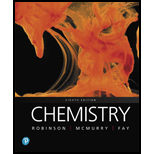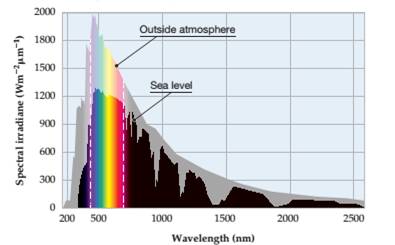
CHEMISTRY-W/MASTERING CHEMISTRY ACCESS
8th Edition
ISBN: 9780135205068
Author: Robinson
Publisher: PEARSON
expand_more
expand_more
format_list_bulleted
Concept explainers
Textbook Question
Chapter 12, Problem 12.102SP
A photovoltaic cell contains a p-n junction that converts solar light to electricity.

(a) Silicon semiconductors with a band-gap energy of 107 kJ/mol are commonly used to make photo voltaic photo voltaic cells. Calculate the wavelength that corresponds to the band-gap energy in silicon.
(b) Compare the by silicon to the wave-lengths of light that reach the as shown in the graph. Does the wavelength to the highest intensity in the solar emission spectrum?
Expert Solution & Answer
Want to see the full answer?
Check out a sample textbook solution
Students have asked these similar questions
in the kinetics experiment, what were the values calculated? Select all that apply.a) equilibrium constantb) pHc) order of reactiond) rate contstant
true or false, given that a 20.00 mL sample of NaOH took 24.15 mL of 0.141 M HCI to reach the endpoint in a titration, the concentration of the NaOH is 1.17 M.
in the bromothymol blue experiment, pKa was measured. A closely related compound has a Ka of 2.10 x 10-5. What is the pKa?a) 7.1b) 4.7c) 2.0
Chapter 12 Solutions
CHEMISTRY-W/MASTERING CHEMISTRY ACCESS
Ch. 12 - Calcium metal crystallizes in a cubic...Ch. 12 - Polonium metal crystallizes in a simple cubic...Ch. 12 - Polonium metal crystallizes in a simple cubic...Ch. 12 - The density of a sample of metal "as measured to...Ch. 12 - Zinc sulfide crystallizes in the following cubic...Ch. 12 - Prob. 12.6ACh. 12 - Prob. 12.7PCh. 12 - Prob. 12.8ACh. 12 - Prob. 12.9PCh. 12 - Prob. 12.10A
Ch. 12 - Prob. 12.11PCh. 12 - Prob. 12.12ACh. 12 - Prob. 12.13PCh. 12 - Prob. 12.14PCh. 12 - Prob. 12.15PCh. 12 - Prob. 12.16PCh. 12 - Prob. 12.17PCh. 12 - Identify each of the following kinds of packingCh. 12 - Prob. 12.19CPCh. 12 - Titanium oxide crystallizes in the following cubic...Ch. 12 - Prob. 12.21CPCh. 12 - Prob. 12.22CPCh. 12 - Prob. 12.23CPCh. 12 - Prob. 12.24CPCh. 12 - Prob. 12.25CPCh. 12 - Prob. 12.26SPCh. 12 - Prob. 12.27SPCh. 12 - Prob. 12.28SPCh. 12 - Prob. 12.29SPCh. 12 - Prob. 12.30SPCh. 12 - Prob. 12.31SPCh. 12 - Diffraction of X rays with =154.2 pm at an angle...Ch. 12 - Diffraction of X rays with =154.2 pm at an angle...Ch. 12 - Which of the four kinds of packing used by metals...Ch. 12 - What is a unit cell? How many atoms are in one...Ch. 12 - Copper crystallizes in a face-centered cubic unit...Ch. 12 - Lead crystallizes in a cubic unit cell with anedge...Ch. 12 - Prob. 12.38SPCh. 12 - Tungsten crystallizes in a body-centered cubic...Ch. 12 - Prob. 12.40SPCh. 12 - Prob. 12.41SPCh. 12 - Titanium metal has a density of and an atomic...Ch. 12 - Calcium metal has a density of 1.55 g/cm3 and...Ch. 12 - The atomic radius of Pb is 175 pm, and the density...Ch. 12 - The density of a sample of metal was measured to...Ch. 12 - If a protein can be induced to crystallize, its...Ch. 12 - The molecular structure of a scorpion toxin, a...Ch. 12 - Iron crystallizes in a body-centered cubic unit...Ch. 12 - Silver metal crystallizes in a face-centered cubic...Ch. 12 - Sodium hydride, NaH, crystallizes in a...Ch. 12 - Cesium chloride crystallizers in a cubic unit cell...Ch. 12 - If the edge length of an NaH unit cell is 488 pm,...Ch. 12 - The edge length of a CsCI unit cell (Problem...Ch. 12 - Silicon carbide, SiC, is a covalent network solid...Ch. 12 - Prob. 12.55SPCh. 12 - Prob. 12.56SPCh. 12 - Prob. 12.57SPCh. 12 - Prob. 12.58SPCh. 12 - Prob. 12.59SPCh. 12 - Prob. 12.60SPCh. 12 - Prob. 12.61SPCh. 12 - Prob. 12.62SPCh. 12 - Prob. 12.63SPCh. 12 - Prob. 12.64SPCh. 12 - Prob. 12.65SPCh. 12 - Prob. 12.66SPCh. 12 - Prob. 12.67SPCh. 12 - Prob. 12.68SPCh. 12 - Prob. 12.69SPCh. 12 - Prob. 12.70SPCh. 12 - Prob. 12.71SPCh. 12 - Prob. 12.72SPCh. 12 - Prob. 12.73SPCh. 12 - Prob. 12.74SPCh. 12 - Prob. 12.75SPCh. 12 - Prob. 12.76SPCh. 12 - Prob. 12.77SPCh. 12 - Prob. 12.78SPCh. 12 - Prob. 12.79SPCh. 12 - Prob. 12.80SPCh. 12 - Prob. 12.81SPCh. 12 - Prob. 12.82SPCh. 12 - Prob. 12.83SPCh. 12 - Prob. 12.84SPCh. 12 - Prob. 12.85SPCh. 12 - Prob. 12.86SPCh. 12 - Prob. 12.87SPCh. 12 - Prob. 12.88SPCh. 12 - Prob. 12.89SPCh. 12 - Prob. 12.90SPCh. 12 - Prob. 12.91SPCh. 12 - Prob. 12.92SPCh. 12 - Prob. 12.93SPCh. 12 - Prob. 12.94SPCh. 12 - Prob. 12.95SPCh. 12 - Prob. 12.96SPCh. 12 - Prob. 12.97SPCh. 12 - Prob. 12.98SPCh. 12 - Prob. 12.99SPCh. 12 - Prob. 12.100SPCh. 12 - Prob. 12.101SPCh. 12 - A photovoltaic cell contains a p-n junction that...Ch. 12 - Prob. 12.103SPCh. 12 - Prob. 12.104SPCh. 12 - Prob. 12.105SPCh. 12 - Prob. 12.106SPCh. 12 - Prob. 12.107SPCh. 12 - Prob. 12.108SPCh. 12 - Prob. 12.109SPCh. 12 - Prob. 12.110SPCh. 12 - Prob. 12.111SPCh. 12 - Prob. 12.112SPCh. 12 - Prob. 12.113SPCh. 12 - Prob. 12.114SPCh. 12 - Prob. 12.115SPCh. 12 - Prob. 12.116SPCh. 12 - Prob. 12.117SPCh. 12 - Prob. 12.118SPCh. 12 - Prob. 12.119SPCh. 12 - Prob. 12.120SPCh. 12 - Prob. 12.121SPCh. 12 - Prob. 12.122SPCh. 12 - Prob. 12.123SPCh. 12 - Prob. 12.124SPCh. 12 - Prob. 12.125SPCh. 12 - Prob. 12.126SPCh. 12 - Prob. 12.127SPCh. 12 - Prob. 12.128SPCh. 12 - Prob. 12.129SPCh. 12 - Prob. 12.130SPCh. 12 - Prob. 12.131SPCh. 12 - Prob. 12.132SPCh. 12 - Prob. 12.133SPCh. 12 - Prob. 12.134MPCh. 12 - Prob. 12.135MPCh. 12 - Prob. 12.136MPCh. 12 - Prob. 12.137MPCh. 12 - Assume that 1588 g of an alkali metal undergoes...Ch. 12 - Prob. 12.139MPCh. 12 - Prob. 12.140MPCh. 12 - Prob. 12.141MPCh. 12 - Prob. 12.142MPCh. 12 - Prob. 12.143MPCh. 12 - Prob. 12.144MP
Knowledge Booster
Learn more about
Need a deep-dive on the concept behind this application? Look no further. Learn more about this topic, chemistry and related others by exploring similar questions and additional content below.Similar questions
- calculate the equilibrium concentration of H2 given that K= 0.017 at a constant temperature for this reaction. The inital concentration of HBr is 0.050 M.2HBr(g) ↔ H2(g) + Br2(g)a) 4.48 x 10-2 M b) 5.17 x 10-3 Mc) 1.03 x 10-2 Md) 1.70 x 10-2 Marrow_forwardtrue or falsegiven these two equilibria with their equilibrium constants:H2(g) + CI2(l) ↔ 2HCI(g) K= 0.006 CI2(l) ↔ CI2(g) K= 0.30The equilibrium contstant for the following reaction is 1.8H2(g) + CI2 ↔ 2HCI(g)arrow_forwardI2(g) + CI2(g) ↔ 2ICIK for this reaction is 81.9. Find the equilibrium concentration of I2 if the inital concentration of I2 and CI2 are 0.010 Marrow_forward
- true or false,the equilibrium constant for this reaction is 0.50.PCI5(g) ↔ PCI3(g) + CI2(g)Based on the above, the equilibrium constant for the following reaction is 0.25.2PCI5(g) ↔. 2PCI3(g) + 2CI2(g)arrow_forwardtrue or false, using the following equilibrium, if carbon dioxide is added the equilibrium will shift toward the productsC(s) + CO2(g) ↔ 2CO(g)arrow_forward2S2O2/3- (aq) + I2 (aq) ---> S4O2/6- (aq) +2I- (aq) Experiment I2 (M) S2O3- (M) Initital Rate (M/s) 1 0.01 0.01 0.0004 2 0.01 0.02 0.0004 3 0.02 0.01 0.0008 Calculate the overall order for this reaction using the table data a) 3b) 0c) 2d) 1arrow_forward
- the decomposition of N2O5 is the first order with a half-life of 1.98 minutes. If the inital concentration of N2O5 is 0.200 M, what is the concentration after 6 minutes?a) 0.612 Mb) 0.035 Mc) 0.024 Md) 0.100 Marrow_forward20.00 mL of 0.150 M HCI is titrated with 0.075 M NaOH. What volume of NaOH is needed?a) 50 mLb) 20 mLc) 40 mLd) 26.66 mLarrow_forward20.00 mL of 0.150 M NaOH is titrated with 37.75 mL of HCI. What is the molarity of the HCI?a) 0.150 Mb) 0.079 Mc) 0.025 Md) 0.050 Marrow_forward
- in the following reaction, the OH- acts as which of these?NO2- (aq) + H2O (l) ⇌ OH- (aq) + HNO2 (aq)a) not a weak acidb) basec) acidarrow_forwardfind the pH of a buffer made from 0.20 M HNO2 and 0.10 M NaNO2. Ka= 4.0 x 10-4a) 4.00b) 3.40c) 3.70d) 3.10arrow_forwardthe Ka for sodium dihydrogen phosphate is 6.32 x 10-8. Find the pH of a buffer made from 0.15 M H2PO4- and 0.15 M HPO42-.a) 6.98b) 7.42c) 7.00d) 7.20arrow_forward
arrow_back_ios
SEE MORE QUESTIONS
arrow_forward_ios
Recommended textbooks for you
 Chemistry: The Molecular ScienceChemistryISBN:9781285199047Author:John W. Moore, Conrad L. StanitskiPublisher:Cengage Learning
Chemistry: The Molecular ScienceChemistryISBN:9781285199047Author:John W. Moore, Conrad L. StanitskiPublisher:Cengage Learning Chemistry: Principles and ReactionsChemistryISBN:9781305079373Author:William L. Masterton, Cecile N. HurleyPublisher:Cengage Learning
Chemistry: Principles and ReactionsChemistryISBN:9781305079373Author:William L. Masterton, Cecile N. HurleyPublisher:Cengage Learning Chemistry: Principles and PracticeChemistryISBN:9780534420123Author:Daniel L. Reger, Scott R. Goode, David W. Ball, Edward MercerPublisher:Cengage Learning
Chemistry: Principles and PracticeChemistryISBN:9780534420123Author:Daniel L. Reger, Scott R. Goode, David W. Ball, Edward MercerPublisher:Cengage Learning Chemistry for Engineering StudentsChemistryISBN:9781337398909Author:Lawrence S. Brown, Tom HolmePublisher:Cengage Learning
Chemistry for Engineering StudentsChemistryISBN:9781337398909Author:Lawrence S. Brown, Tom HolmePublisher:Cengage Learning Chemistry & Chemical ReactivityChemistryISBN:9781337399074Author:John C. Kotz, Paul M. Treichel, John Townsend, David TreichelPublisher:Cengage Learning
Chemistry & Chemical ReactivityChemistryISBN:9781337399074Author:John C. Kotz, Paul M. Treichel, John Townsend, David TreichelPublisher:Cengage Learning Principles of Modern ChemistryChemistryISBN:9781305079113Author:David W. Oxtoby, H. Pat Gillis, Laurie J. ButlerPublisher:Cengage Learning
Principles of Modern ChemistryChemistryISBN:9781305079113Author:David W. Oxtoby, H. Pat Gillis, Laurie J. ButlerPublisher:Cengage Learning

Chemistry: The Molecular Science
Chemistry
ISBN:9781285199047
Author:John W. Moore, Conrad L. Stanitski
Publisher:Cengage Learning

Chemistry: Principles and Reactions
Chemistry
ISBN:9781305079373
Author:William L. Masterton, Cecile N. Hurley
Publisher:Cengage Learning

Chemistry: Principles and Practice
Chemistry
ISBN:9780534420123
Author:Daniel L. Reger, Scott R. Goode, David W. Ball, Edward Mercer
Publisher:Cengage Learning

Chemistry for Engineering Students
Chemistry
ISBN:9781337398909
Author:Lawrence S. Brown, Tom Holme
Publisher:Cengage Learning

Chemistry & Chemical Reactivity
Chemistry
ISBN:9781337399074
Author:John C. Kotz, Paul M. Treichel, John Townsend, David Treichel
Publisher:Cengage Learning

Principles of Modern Chemistry
Chemistry
ISBN:9781305079113
Author:David W. Oxtoby, H. Pat Gillis, Laurie J. Butler
Publisher:Cengage Learning
ENVIRONMENTAL POLLUTION; Author: 7activestudio;https://www.youtube.com/watch?v=oxtMFmDTv3Q;License: Standard YouTube License, CC-BY